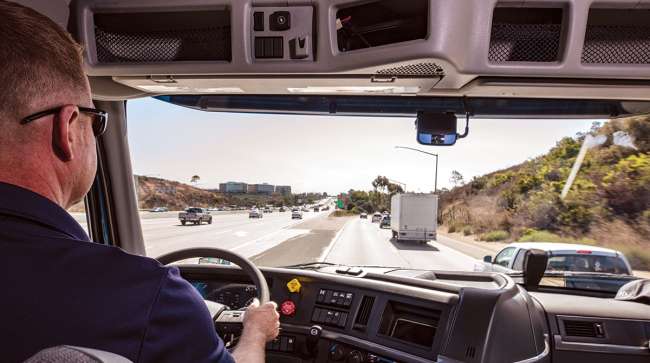Staff Reporter
Lytx: Idling Time Dropped by 16% in 2022

[Stay on top of transportation news: Get TTNews in your inbox.]
Fleets around the world experienced a 16% year-over-year decline in idling time in 2022, according to customer data from video telematics company Lytx.
The 2023 State of the Data Report released May 23 noted the reduction in vehicle idling prevented more than 90 million tons of carbon dioxide emissions and over $24 million in wasted fuel. Lytx used data collected for its fleet customers, but the underlying causes reflect a broader trend.
“I don’t think this necessarily speaks to just the Lytx types of solutions, but it’s also just the general operating environment of our fleets,” said David Riordan, executive vice president and general manager of enterprise. “It’s helpful to make them each individually aware of idling. But at a real top level, increasing utilization of trucks means they’re on the road and moving more often, so there’s less opportunity to idle.”
Lytx found in the report that the reduction was driven by improved utilization and reduced wait times. It noted dramatic disruptions to the supply chain in the prior two years worsened wait times at facilities. But as the supply chain recovered, the report said, idling-related losses and pollution dropped measurably.
“It’s more of a reflection on the entire industry and its supply and demand mix between the number of trucks available and what they’re actually doing,” Riordan said. “Just some of the environmental issues of supply change crises, backing people up in the ports and things like that. So, it was unexpected. We had no pre-ordained impression about what we’d see, and it was just interesting when we saw that. And then we clicked in a couple of notches to see what might be driving it.”
Lytx developed the report using data from the over 2.1 million drivers on its platform globally. The telematics company noted that findings were further derived by processing more than 145 million events and over 55 billion minutes of video from vehicles.
“I think what is valuable to us every year that we do this is it’s validating and affirming on some of the things that we talk to our clients about every day,” Riordan said. “Just the challenges and specific driving behaviors, driving environments and trends that they’re seeing in their business.
I think what is valuable to us every year that we do this is it’s validating and affirming on some of the things that we talk to our clients about every day.
David Riordan, executive vice president and general manager of enterprise at Lytx
Image
“And what this gives us a chance to do is pull it up to probably above the 10,000-foot level, to the 100,000-foot level, and just reflect on the year. I think the big takeaway for us this last year is 2022 is really getting back to business in full post-pandemic.”
Lytx also found in the report collisions decreased by 23.1% from 2019 to 2022. The report used the year before the pandemic as a benchmark to reflect a normal freight environment. It also found overall risky driving improved by 29% over that time. But unlike idling times, these improvements didn’t reflect the industry overall.
Powered by over 221 billion miles of driving data, Lytx’s 2023 State of the Data report reveals new safety trends and provides valuable insights that can help fleets improve driver and road safety, save costs, and increase operational efficiency. https://t.co/epRZtRMT4M pic.twitter.com/dmhPGEdjcv — Lytx (@lytx) May 23, 2023
“There definitely has been supportive evidence from all of our videos and from our client discussions about how the roads were getting more congested, but they were still at speed,” Riordan said. “In that backdrop of increasing risk during this transition from pre-pandemic to full back-to-business, the outside environment got significantly more congested and riskier. But our clients being on top of that actually improved their overall per-mile collision rates and many of their per-mile key risky behaviors.”
Riordan noted that the data also showed that the risk is not homogenously spread. Instead, there are hot spots that come up in the findings such as around ports, construction sites, intersections and airports. The report found 14 out of 30 of the highest-risk sections of public and private roadways were within 2 miles of airports in 2022. That is up 86% from 2021.

Warlick
“Airports likely stand out as having among the more dangerous roadways due to several factors, including the high number of intersections and transitions, the high percentage of drivers unfamiliar with the routes, the high concentration of cars and, of course, hurried or distracted behaviors such as looking at mobile phones,” said Kyle Warlick, senior client intelligence analyst.
The report also found most collisions happen in clear weather and often are due to animal strikes. It noted 13.1% of collisions occurred during rainy weather, 83.9% in clear conditions and 2.9% in snowy weather. Animal strikes accounted for 29.7% of the collisions in clear weather and 9.4% in rainy conditions.
“It’s kind of like this juxtaposition of, it’s really helpful to be armed with the data and armed with your own performance so that you can actually avoid the macro trends and let that come out better,” Riordan said. “I think that was borne out over the entire Lytx fleet. And so, a lot of those stats are against that backdrop of largely the macro environment getting riskier.”
Want more news? Listen to today's daily briefing below or go here for more info:





